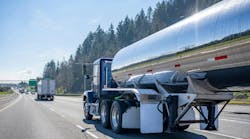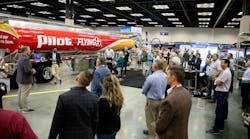Seventeen fleets operating more than 62,000 tractors and 217,000 trailers saw a 3% increase in fuel economy in 2015, saving an accumulative $501 million on fuel when compared to the 2015 national average fuel spend of 1.7 million over-the-road class 8 trucks. They achieved these gains by purchasing a variety of fuel efficiency technologies, according to the Annual Fleet Fuel Study released by the North American Council for Freight Efficiency (NACFE).
As a result of these investments, fleet-wide miles per gallon increased from 6.87 to 7.06 in 2015, the largest margin of improvement in eight years of consecutive improvements. The trade cycle for these fleets is a little over five years, meaning that the new trucks are about 16% more efficient than the 2010 model year trucks they replaced.
The adoption rate of new efficiency technologies such as electronically controlled transmissions, low-viscosity engine oil, and tire pressure inflation on trailers continued to increase even though diesel fuel prices averaged $2.71 in 2015.
The 17 fleets included in the study achieved this high level of fuel efficiency by adopting a combination of nearly 70 currently available technologies, which are reviewed in a series of publicly available Trucking Efficiency Confidence Reports that assess current technologies, discuss challenges and best practices for their adoption, and provide figures on performance gains and payback periods. Trucking Efficiency is a joint effort of NACFE and Carbon War Room (CWR). With upcoming Confidence Reports on platooning and engine accessories, Trucking Efficiency will continue to promote profitable, fuel-saving opportunities in the industry.
“Improvements in both the fuel economy and bottom lines of the leading fleets this year provide a compelling call to action for the rest of the industry,” says Mike Roeth, operation lead for CWR’s Trucking Efficiency and executive director of NACFE. “Investing in efficiency technologies is the new normal. And these fleets are continuing to make investments because they do not want to be caught short when fuel prices go up again.”
Fleets that participated in the study are increasing their adoption of technologies that will likely be required under Greenhouse Gas Phase 2 (GHG2) regulations, yet “there is clearly a need to increase the confidence in and/or payback of many of these technologies for wider-scale use,” Roeth says. “Manufacturers must improve the availability and payback of these technologies to profitably meet the requirements of the final GHG2 regulations.”
Since 2011, NACFE has conducted its Annual Fleet Fuel Study to report on innovative fleets that have committed to improving fuel efficiency. Fleets that participate in the study share their implementation experiences as well as best practices for using these technologies. The study provides insights to help other fleets make better-informed business decisions about adding these fuel efficiency technologies and practices in the future.








